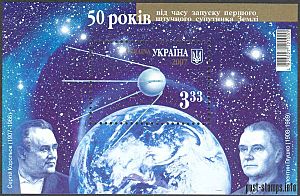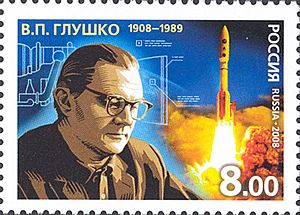Valentin Glushko facts for kids
Valentin Petrovich Glushko (Russian: Валенти́н Петро́вич Глушко́; Ukrainian: Валентин Петрович Глушко, romanized: Valentyn Petrovych Hlushko; born 2 September 1908 – 10 January 1989) was a famous Soviet engineer. He was the main designer of rocket engines for the Soviet space program. This was during the exciting time of the Space Race between the United States and the Soviet Union. He also wrote the world's first "Cybernetics Encyclopedia."
Contents
Life and Work
Early Life and Interest in Rockets
When Valentin Glushko was 14, he became very interested in aeronautics (the study of flight). This happened after he read books by Jules Verne, a famous science fiction writer. In 1923, he even wrote a letter to Konstantin Tsiolkovsky, who is known as a pioneer of rocketry.
Glushko went to a trade school in Odessa, where he learned to work with sheet metal. After school, he worked at a factory, first as a fitter, then as a lathe operator. While in Odessa, he experimented with explosives he found from old artillery shells. From 1924 to 1925, he wrote articles about exploring the Moon and using Tsiolkovsky's ideas for space flight.
Studying and Early Rocket Research
He later attended Leningrad State University to study physics and mathematics. However, he felt the programs weren't exactly what he wanted, and he left in 1929. From 1929 to 1930, he worked on rocket research at the Gas Dynamics Laboratory (GDL). Here, a new section was created to study engines that used liquid fuel and electric power. He later joined the Reactive Scientific Research Institute in 1931. This institute was formed when GDL joined with another group called the Group for the Study of Reactive Motion (GIRD).
Challenges and Contributions During Wartime
In 1938, Glushko faced a difficult time and was held in the Butyrka prison. By 1939, he was sentenced to eight years. However, he was put to work on different aircraft projects with other scientists who were also held. In 1941, he was put in charge of designing liquid-fueled rocket engines. He was finally released in 1944. That same year, he and Sergei Korolev designed a special rocket motor. It was tested on a Lavochkin La-7R plane to help protect the capital city from high-flying enemy planes.
Leading Rocket Engine Design
After World War II, Glushko went to Germany and Eastern Europe to learn about Germany's rocket program. In 1946, he became the chief designer of his own design bureau, called OKB 456. He stayed in this role until 1974. This bureau became very important in creating rocket engines for the Soviet Union.
His team designed many powerful engines. These included the RD-101 engine for the R-2 rocket, the RD-110 for the R-3, and the RD-103 for the R-5 Pobeda rocket. The famous R-7 Semyorka rocket, which launched the first satellite, used four of Glushko's RD-107 engines and one RD-108 engine. In 1954, he started designing engines for the R-12 Dvina rocket. He also provided rocket engines for Sergei Korolev's R-9 Desna rocket. One of his most powerful designs was the RD-170 liquid propellant engine.
Space Program Leadership and New Rockets
In 1974, after the American moon landings, the Soviet leader Leonid Brezhnev decided to stop the Soviet program to send people to the Moon. He combined many parts of the Soviet space program into one big organization. Glushko was chosen to lead this new organization, which was later named NPO Energia.
One of Glushko's first big decisions was to stop the N-1 rocket program. He had often criticized this program. He then started working on a completely new very large rocket called Energia. At this time, the US was developing its Space Shuttle.
Glushko decided that the new Energia rocket would use only liquid-fueled engines. Its main core stage would use liquid hydrogen fuel, similar to the Space Shuttle's main engines. It would also have powerful side boosters that used liquid oxygen and kerosene with his RD-170 engines.
The RD-120 engine for Energia's core stage was developed quickly. However, the RD-170 was harder to perfect. Glushko decided to use an engine with four combustion chambers (where fuel burns) fed by one fuel line. The RD-170 engines designed for Energia's boosters also became the basis for the Zenit rocket family, which started flying in 1985.
Energia's first flight in May 1987 carried a prototype space station module called Polyus. Later, the Buran space shuttle, which Energia was designed to launch, flew in the summer of 1988, just a few months before Glushko passed away. Even though Energia and Buran were stopped after the Soviet Union broke apart, the RD-170 engines and their newer versions are still used today.
Legacy and Challenges
Glushko's team was part of the Soviet Ministry of General Machine Building. Before he died, he chose Boris Gubanov to take over his work. Valentin Glushko died on January 10, 1989. Many important leaders, including Mikhail Gorbachev, signed his obituary. He was buried in Novodevichy Cemetery in Moscow.
One challenge Glushko faced was his strong belief that hydrogen fuel was not good for rockets. This meant the Soviet space program was still discussing hydrogen engines while the Americans were already building the Saturn V rocket, which used hydrogen. Also, Glushko's team found it hard to build a single large engine using liquid oxygen and kerosene that could compete with the American F-1 engine used on the Saturn V. Instead, he developed the RD-270, a very powerful engine using different types of fuel.
His solution for powerful engines using kerosene was the RD-170. This engine uses four smaller combustion chambers that share fuel. This design gave the Soviets the huge power needed for the Energia rocket and shows Glushko's great engineering skills.
Honours and Awards

Valentin Glushko received many important awards and honours for his work:
- Hero of Socialist Labour, twice (1956, 1961) - This was a very high honour for his contributions.
- Order of Lenin, five times (1956, 1958, 1961, 1968, 1978)
- Order of the October Revolution (1971)
- Order of the Red Banner of Labour (1945)
- Jubilee Medal "For Valiant Labour. To commemorate the 100th anniversary of the birth of Vladimir Ilyich Lenin" (1970)
- Jubilee Medal "Thirty Years of Victory in the Great Patriotic War 1941-1945" (1975)
- Jubilee Medal "Forty Years of Victory in the Great Patriotic War 1941-1945" (1985)
- Medal "For Valiant Labour in the Great Patriotic War 1941-1945" (1945)
- Medal "Veteran of Labour" (1984)
- Medal "In Commemoration of the 800th Anniversary of Moscow" (1948)
- Lenin Prize (1957)
- USSR State Prize (1967, 1984)
- Gold Medal from the Tsiolkovsky Academy of Sciences of the USSR (1958)
- Diploma of them. Paul Tissandier (FAI) (1967)
- He was made an Honorary Citizen of Korolyov, a city important to the space program.
- An Asteroid (number 6357), discovered in 1976, was named in his honour.
- A crater on the Moon, called Glushko, is named after him.
- An avenue in Kyiv, the capital of Ukraine, is named after Glushko.
See also
 In Spanish: Valentín Glushkó para niños
In Spanish: Valentín Glushkó para niños



